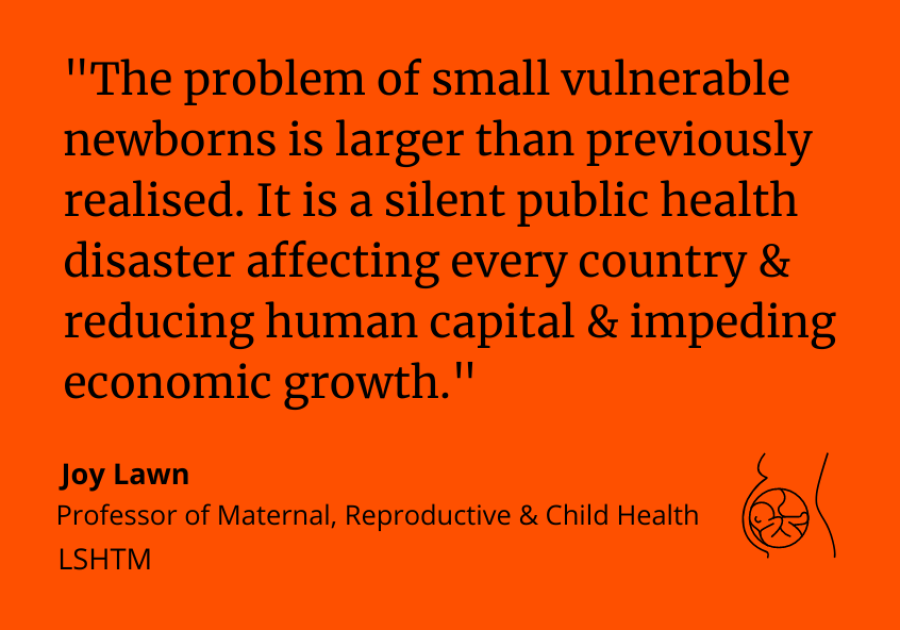Quarter of all babies worldwide are born too soon or too small
9 May 2023 London School of Hygiene & Tropical Medicine London School of Hygiene & Tropical Medicine https://lshtm.ac.uk/themes/custom/lshtm/images/lshtm-logo-black.png
One in four (35.3 million) babies born in 2020 were preterm or small for their gestational age, according to a new Series launched by The Lancet.
Born in every country worldwide, with the majority in Sub-Saharan Africa and Southern Asia, these newborns are at a higher risk of death in their first few weeks of life, with potential lifelong negative impacts on these children and their families.
The London School of Hygiene & Tropical Medicine (LSHTM) led the analyses on preterm birth rates for all countries and trends 2010-2020, as well as combining global data on babies born both ‘too soon’ and ‘too small’ for the first time under the umbrella term small vulnerable newborns (SVNs). The Series is composed of three papers, all involving contributions from LSHTM.
Importantly the 35.3 million figure includes only live born babies and not stillbirths that are preterm or small, so the overall impacts on the health and wellbeing of families is likely to be even greater. 75% of stillbirths were born preterm in a new analysis of 20 years of national data from 12 middle and high-income countries.
Rates of low birthweight are static, with only a 0.59% estimated annual rate of reduction of babies with low birthweight since 2012. This progress is off track from the World Health Assembly Global Nutrition Target of 30% reduction of low birthweight by 2030.
As part of this call to action, the team suggest eight interventions for pregnant women in 81 low-and middle- income countries that they estimate could prevent 566,000 stillbirths and 5.2 million babies from being born preterm or too small. Interventions include preventing malaria, and treating syphilis in pregnancy, as well as smoking cessation. Although implementing all of these eight interventions could cost an estimated $1.1 billion in 2030, the authors argue that the associated deaths averted and long-term health and economic benefits justify this investment.
With more than 80% of births now taking place in health facilities, the team also emphasise that we are in a better position than ever to ensure that gestational age is accurately recorded for every pregnancy and that all newborns, including stillbirths, are classified by SVN type. In doing so, they state that individual care could be improved, as well as the possibility to track progress and drive accountability. Since stillbirths are commonly born preterm, the authors highlight that only focusing on livebirths could mean that the true burden of SVNs and the wider impacts on women, families and society is missed.
Joy Lawn, lead co-author on the estimates and co-author on the other papers in the series and Professor of Maternal, Reproductive & Child Health at LSHTM said:
“Our first ever estimates on this topic show that the problem of small vulnerable newborns (SVNs) is larger than previously realised, and is a silent public health disaster affecting every country and reducing human capital and impeding economic growth. Our new estimates included inputs from a database with over 160 million live births, allowing us to examine the mortality risk for each SVN type. The highest mortality risk is for babies who are born both too soon and too small, but these babies are is only 1.1% of the world’s births. Mortality impact is driven by being born too soon (preterm), which accounts for three quarters of the deaths. Importantly a similar proportion of the world’s stillbirths are also preterm.”
The full Lancet Small Vulnerable Newborn Series can be accessed here. The journal is also hosting a launch event in Cape Town, South Africa on Tuesday 9th May at 16:30 BST/11:30 ET. Registration is now open.
A series of linked papers in the British Journal of Obstetrics and Gynaecology provide details of the big dataset analyses that are the inputs to the new estimate and can be accessed here.
LSHTM's short courses provide opportunities to study specialised topics across a broad range of public and global health fields. From AMR to vaccines, travel medicine to clinical trials, and modelling to malaria, refresh your skills and join one of our short courses today.